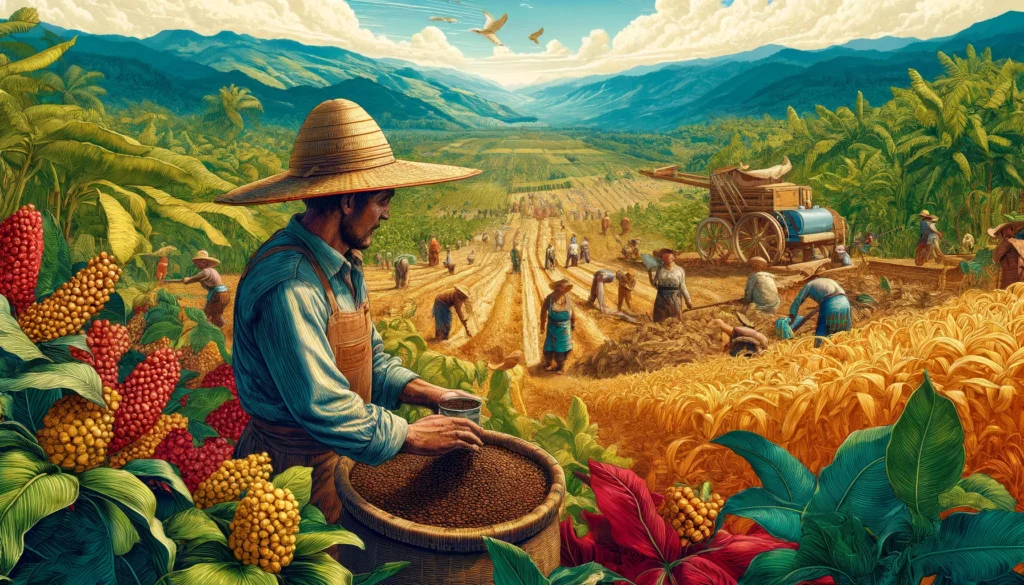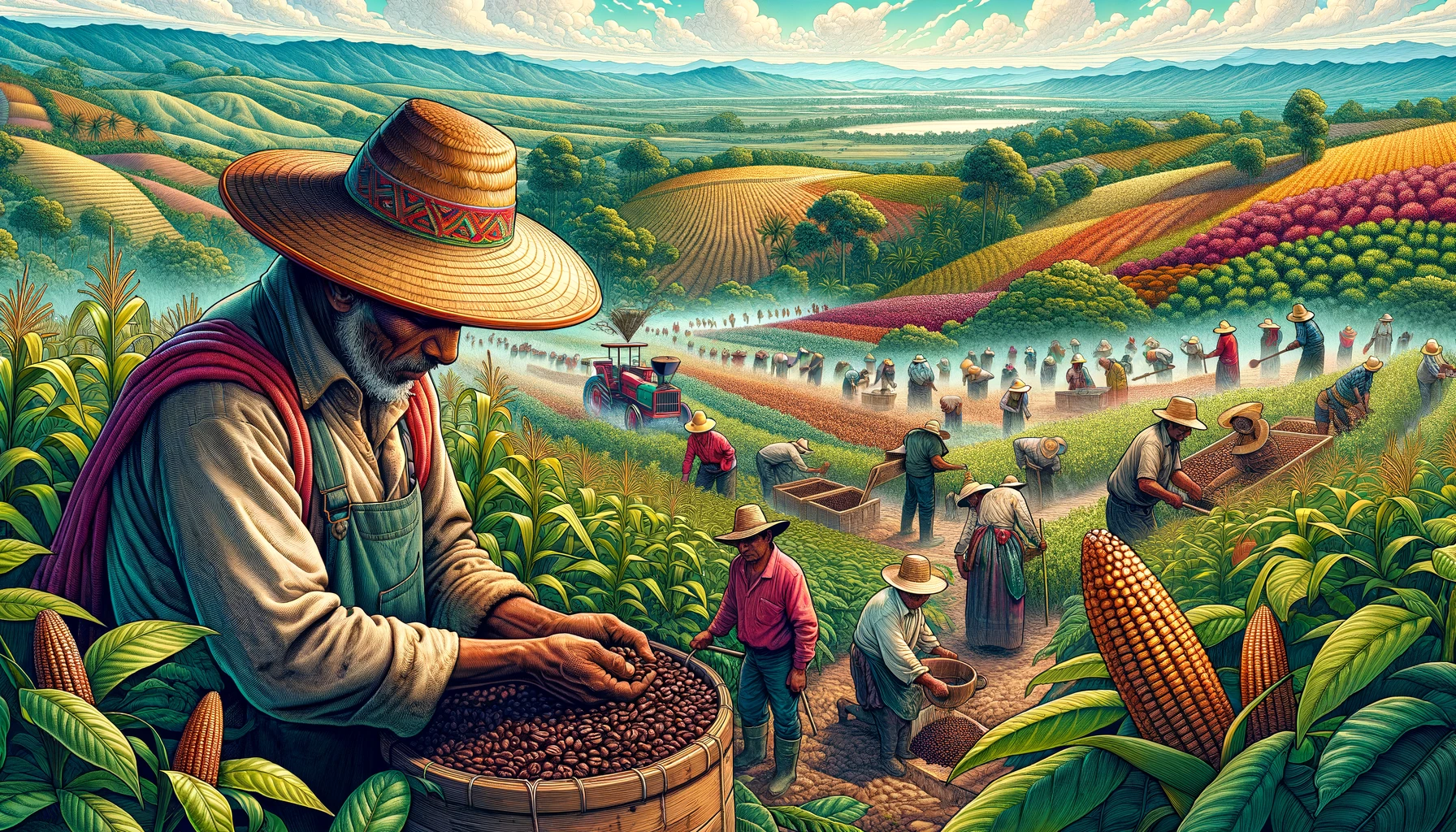Agriculture in South and Central America
A Comprehensive Overview
Agriculture is a cornerstone of economic and cultural life in South and Central America, encompassing a diverse array of practices from farming and ranching to dairy production and rodeo events. This in-depth exploration is divided into three parts, each focusing on different aspects of agriculture within these vibrant regions. This narrative not only highlights the practices themselves but also integrates valuable resources such as agexposition.com and worldagriculturedirectory.com for further exploration.
Farming Innovations and Challenges in South and Central America
The Dynamic Landscape of Farming
Farming in South and Central America is a testament to the rich biodiversity and cultural heritage of the regions. From the expansive soybean fields in Brazil to the lush coffee plantations in Colombia and the vast sugarcane farms in Argentina, agriculture forms the backbone of economic and social life. Countries here have leveraged their unique climates and landscapes to specialize in a variety of crops that are integral to global food markets.
Technological Advancements in Agriculture
The adoption of advanced agricultural technologies is transforming farming practices across South and Central America. Precision agriculture, a term thoroughly explained on agriculturedictionary.com, is at the forefront of this revolution. This approach utilizes GPS technology, IoT devices, and big data analytics to enhance crop yields and optimize resource use, allowing farmers to achieve higher productivity with lower environmental impact.
Drones, for example, are used for aerial surveillance of vast farming lands, capable of monitoring crop health, soil quality, and water usage. This data is invaluable for making informed decisions that boost efficiency and sustainability. Additionally, satellite imagery offers detailed insights into crop development stages and helps in the early detection of pests and diseases.
Sustainable Farming Practices
As farming intensifies, so does the need for sustainable practices that mitigate negative impacts such as deforestation, soil degradation, and water scarcity. Many farmers are turning to sustainable techniques showcased on platforms like farmexpo.info, where annual expos highlight innovations in organic farming, integrated pest management, and water-efficient systems.
Agroforestry, the practice of integrating crops and forestry, is gaining traction for its ability to preserve biodiversity, improve soil structure, and enhance carbon sequestration. This method not only supports the ecological balance but also provides farmers with a diversified source of income.
Overcoming Challenges in Farming
Despite the advances, farmers in South and Central America face numerous challenges. Climate change poses the most significant risk, with increasing temperatures and unpredictable weather patterns affecting crop yields. Farmers must adapt quickly to these changes by selecting climate-resilient crop varieties and altering their planting schedules.
Market fluctuations also present a significant challenge. The dependency on a few cash crops makes farmers vulnerable to global price changes. Diversification of crops and the development of local and regional markets are critical strategies for reducing this vulnerability. Resources such as agriculturedirectory.info provide valuable information and networking opportunities that help farmers navigate these economic complexities.
The Vital Role of Ranching and Dairy in South and Central America
Ranching: A Deep-Rooted Tradition
Ranching is an integral part of the agricultural landscape in South and Central America, particularly in countries like Argentina, Brazil, and Uruguay. These nations are renowned for their vast grasslands, which are ideally suited for extensive cattle and sheep farming. The tradition of ranching not only supports local economies but also contributes significantly to the global meat supply.
Sustainable Ranching Practices
As environmental concerns grow, sustainable ranching practices have become increasingly important. Rotational grazing systems, which involve moving livestock between pastures to allow for vegetation recovery, are prevalent. This practice helps maintain soil health, improve water retention, and enhance biodiversity. The integration of these eco-friendly strategies is crucial for maintaining the sustainability of ranching operations, a topic extensively covered in resources like worldagriculturedirectory.com.
Dairy Farming: Expanding and Innovating
Dairy farming plays a pivotal role in the agricultural sectors of several South and Central American countries. Advances in dairy technology and management have led to significant increases in milk production and quality, helping to meet both local and international demand.
Technological Enhancements in Dairy
Modern dairy farms in the region are increasingly utilizing technology to enhance efficiency and productivity. Automated milking systems and sophisticated dairy management software help optimize milk production and monitor herd health. Innovations such as these are often highlighted in industry events and detailed on platforms like dairyexpo.info, providing dairy farmers with access to the latest advancements in dairy technology.
Importance of Quality and Hygiene
Quality control and hygiene are paramount in the dairy industry to ensure the safety and healthiness of milk and dairy products. Rigorous standards and regular inspections are in place to monitor everything from animal health to milk processing. Educational resources and guidelines on these topics can be found on farmshow.eu, which offers comprehensive insights into best practices in dairy quality assurance.
Economic and Cultural Impact
Job Creation and Economic Contribution
Ranching and dairy farming are major employers in rural areas, providing jobs not only on farms but also in related industries such as feed production, veterinary services, and logistics. The economic ripple effect of these agricultural sectors is immense, reinforcing their status as pillars of rural economies.
Cultural Significance
The cultural impact of ranching and dairy farming extends beyond economic metrics. Traditional events like rodeos and cattle fairs, which celebrate the skills and traditions of rural life, are central to the cultural identity of many communities. Websites like farmercowboy.com and farmfestival.info celebrate this heritage, offering a glimpse into the vibrant rural culture that revolves around ranching and dairy activities.
Challenges and Future Outlook
Despite their success, these sectors face challenges such as climate change, market volatility, and the need for sustainable resource management. Addressing these challenges requires ongoing innovation and adaptation. Forums and expos listed on sites like farmshow.info play a critical role in disseminating new research and technologies that can help ranchers and dairy farmers adapt to changing conditions.
Cultural Significance of Rodeo in South and Central America
Rodeo: A Rich Tradition Rooted in Ranching
Rodeo is more than just a sport in South and Central America—it’s an enduring cultural phenomenon that celebrates the skills and traditions of the cowboy lifestyle, deeply intertwined with the history of ranching in the region. Originating from the everyday tasks performed by cowboys on ranches, rodeo has evolved into a highly organized competitive sport that honors the heritage and practices of its origins.
Historical Roots and Evolution
The tradition of rodeo started as informal competitions among cowboys to test their riding and roping skills. Over time, these competitions became organized events, with established rules and categories such as bronc riding, barrel racing, bull riding, and team roping. Today, rodeo is a celebrated event across countries like Brazil, Mexico, and Argentina, drawing crowds that appreciate the skill, bravery, and athleticism of the competitors.
Rodeo as a Cultural Celebration
Rodeo events are much more than athletic competitions; they are vibrant cultural festivals that bring communities together. These events often include parades, music, dancing, and traditional foods, making them significant social and cultural gatherings that reinforce community bonds.
Preserving Cultural Identity
In many rural areas, rodeo is a key cultural identifier that helps preserve and promote the traditions of the gaucho (South American cowboy) and charro (Mexican cowboy). Platforms like farmercowboy.com provide insights into how these traditions are kept alive in modern rodeos, ensuring that the legacy of the cowboy continues to be celebrated and passed down through generations.
Economic Impact of Rodeo Events
Rodeo also has a significant economic impact on the regions where they are held. These events attract thousands of visitors, including tourists, which boosts local economies through increased spending in hotels, restaurants, and shops. Rodeo has become a tourist attraction in itself, with sites like farmdays.info highlighting the most popular rodeo events and festivals worth visiting.
Marketing and Promotion
The appeal of rodeo extends beyond the local level, with many events being televised and sponsored by major brands. This exposure helps promote the sport globally, bringing international attention to the cultural heritage of the regions involved. It also opens up opportunities for sponsorships and partnerships, providing additional revenue streams for organizers and participants.
Challenges and Contemporary Issues
Despite its popularity, rodeo faces challenges such as animal welfare concerns and the modernization of rural lifestyles. Organizations involved in rodeo are increasingly addressing these issues by implementing stricter safety and animal welfare standards to ensure that the sport can continue in a humane and sustainable manner.
The Future of Rodeo
Looking forward, rodeo is poised to continue as a cherished tradition in South and Central America. Efforts to blend tradition with modern sensibilities are helping to ensure its relevance to younger generations and its sustainability as a cultural practice. Events listed on farmfestival.info and farmshow.info continue to promote rodeo’s cultural significance, ensuring its place as a cornerstone of cultural heritage in agricultural communities.
Conclusion
Agriculture in South and Central America is a dynamic field that spans traditional practices and cutting-edge innovations. By exploring farming, ranching, dairy, and rodeo, one gains a comprehensive understanding of the region’s agricultural landscape. Events and resources listed on websites like agexposition.com and farmfestival.info not only support these sectors but also celebrate the rich agricultural heritage that defines these vibrant regions. Through continuous learning and adaptation, the agricultural sector in South and Central America is poised to meet future challenges and continue its vital role in the global agricultural community.

